#Extracting Restaurant Data
Explore tagged Tumblr posts
Text
The Deliveroo API offers a seamless solution for Extracting Restaurant Data to drive valuable business insights. With effortless integration, businesses can access a wealth of information, including menus, customer reviews, and order statistics. By leveraging this API, businesses can make data-driven decisions, optimize operations, and gain a competitive edge in the food delivery industry.
0 notes
Text

Lensnure Solution provides top-notch Food delivery and Restaurant data scraping services to avail benefits of extracted food data from various Restaurant listings and Food delivery platforms such as Zomato, Uber Eats, Deliveroo, Postmates, Swiggy, delivery.com, Grubhub, Seamless, DoorDash, and much more. We help you extract valuable and large amounts of food data from your target websites using our cutting-edge data scraping techniques.
Our Food delivery data scraping services deliver real-time and dynamic data including Menu items, restaurant names, Pricing, Delivery times, Contact information, Discounts, Offers, and Locations in required file formats like CSV, JSON, XLSX, etc.
Read More: Food Delivery Data Scraping
#data extraction#lensnure solutions#web scraping#web scraping services#food data scraping#food delivery data scraping#extract food ordering data#Extract Restaurant Listings Data
2 notes
·
View notes
Text
How to Optimize Your Restaurant Menu for Online Ordering Systems?
Optimize your restaurant menu for online ordering systems with expert Restaurant Menu Entry Services. These services ensure your menu is clear, visually appealing, and easy to navigate. By accurately categorizing items, adding high-quality images, and providing detailed descriptions, Restaurant Menu Entry Services enhance customer experience and boost online sales. Trust professionals to streamline your menu for maximum efficiency and customer satisfaction.
0 notes
Text
Restaurant Data Analytics Services - Restaurant Business Data Analytics
Restaurant data analytics services to turn raw restaurant data into actionable insights. Make data-driven decisions to boost your business in today’s competitive culinary landscape. Our comprehensive restaurant data analytics solutions empower you to optimize operations, enhance customer experiences, and boost profitability. Our team of seasoned data analysts strives hard to deliver actionable data insights that drive tangible results.
#Restaurant data analytics services#Data Analytics#restaurant data analytics solutions#Scraping restaurant data#food delivery service#Food Data Scraping Services#web scraping services#web scraping#web data extraction#Restaurant Data Scraper#price monitoring services#monitor competitor’s prices
1 note
·
View note
Text
Tripadvisor Scraping | Extract Hotels and Restaurants Data
Enhance your travel insights with our TripAdvisor Scraping service. Effortlessly extract hotels and restaurants data for informed travel decisions and analysis.
#Tripadvisor Scraping#Extract Hotels Data#Extract Restaurants Data#Extract TripAdvisor Data#Scrape TripAdvisor Data API
0 notes
Text
How to Use Zomato API to Scrape Restaurant Data – A Detailed Guide

Introduction
In the dynamic world of digital gastronomy, where culinary delights and dining experiences are increasingly explored and celebrated online, the demand for up-to-date restaurant data is insatiable. As food enthusiasts and businesses seek the latest insights into menus, reviews, and more, the Zomato API emerges as a powerful tool for scraping this invaluable information.
Our comprehensive guide delves into the intricate art of utilizing the Zomato API to scrape restaurant data. Whether you're a restaurateur striving to understand your competitors, a food blogger searching for fresh content, or a data enthusiast eager to explore culinary trends, this guide will serve as your compass in the world of data extraction.
We will navigate through the intricacies of Zomato Scraper, uncovering its capabilities to provide you with rich, real-time restaurant data. From scraping restaurant details to accessing customer reviews, our detailed guide ensures that you harness the full potential of this resource.
Prepare to embark on a data-driven culinary journey, where you'll unlock a wealth of insights, enabling you to make informed decisions, craft engaging content, and explore the ever-evolving realm of restaurant experiences. Welcome to a world where the digital table is set, and the Zomato API is your key to an exquisite menu of data-driven possibilities.
Zomato: Transforming the Restaurant Business
In the bustling realm of the restaurant business, where culinary arts meet customer preferences, Zomato has emerged as a transformative force. With its roots in India, Zomato has rapidly evolved into a global restaurant discovery and food delivery platform, redefining how we explore, experience, and engage with dining establishments.
Zomato's journey began as a humble restaurant review website, helping diners discover new places to eat, explore menus, and share their dining experiences. Over time, it expanded its horizons to offer a comprehensive ecosystem for diners and restaurateurs.
Zomato is a one-stop destination for diners to explore an extensive database of restaurants, read authentic reviews, view ratings, and even reserve tables. Its user-friendly interface and intuitive features make finding the perfect dining spot for any occasion more accessible.
However, Zomato's impact transcends the diner's experience alone. It has revolutionized the restaurant business by empowering restaurateurs with valuable insights and tools. Through its services, restaurants can establish a digital presence, organize their online reputation, and reach a broader audience. Zomato has become a trusted partner for restaurant owners looking to boost their visibility and attract new customers.
One of Zomato's standout features is its data-driven approach. It collects vast data on restaurant menus, pricing, user reviews, and more. This data is a goldmine for restaurateurs, helping them make informed decisions about their offerings and pricing strategies. It also facilitates data-driven marketing and personalized customer engagement.
Moreover, Zomato's foray into food delivery services has further revolutionized the industry. With the convenience of ordering food from your favorite restaurant and delivering it to your doorstep, Zomato has disrupted the traditional dining experience. Its efficient delivery network has made it a go-to platform for foodies craving restaurant-quality meals from the comfort of their homes.
In a fast-changing and very competitive industry, Zomato continues to innovate, adapting to the evolving needs and preferences of diners and restaurant owners. It has not only transformed the way we discover and enjoy food but has also empowered restaurants to thrive in the digital age. As Zomato continues to expand its global footprint, it remains a dynamic and influential player in the restaurant business, shaping the future of dining experiences.
What Data Can You Get from Zomato?
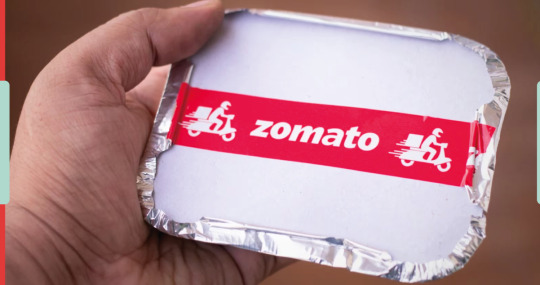
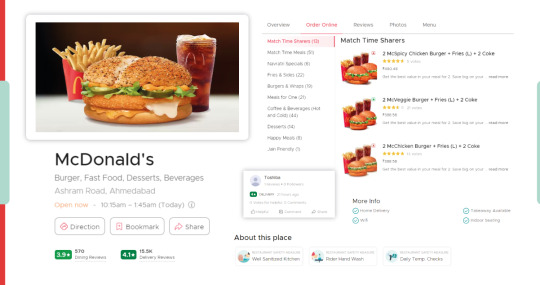
Restaurant Information
Restaurant Name
Address
Phone Number
Operational Hours
Cuisine Type
Location (Latitude and Longitude)
Menu Data
Menu Items
Dish Names
Descriptions
Prices
User Reviews and Ratings
User Reviews
User Ratings
Comments
User Profile Information
Photos
Restaurant Images
Food Images
User-Uploaded Photos
Table Reservations
Availability
Reservation Options
Booking Confirmation
Restaurant Features
Amenities (e.g., Wi-Fi, Parking)
Accepted Payment Methods
Delivery and Takeout Information
Delivery Availability
Delivery Areas
Delivery Times
Minimum Order Amount
Restaurant Attributes
Zomato Rating
Cost for Two
Zomato Gold and Zomato Pro Availability
Location Data
Geographical Coordinates
Nearby Restaurants
User Profile Data (if registered)
Name
Profile Picture
Review History
Event Information (if applicable)
Upcoming Events
Event Details
Statistics and Analytics
Insights on User Activity
Trend Analysis
Popular Dishes
Dish Names
Ratings
User Reviews
It's important to note that the availability of these data fields may vary depending on the specific API endpoints and services you are using within Zomato. Additionally, Zomato may periodically update and expand the data fields to enhance the user and developer experience. When working with Zomato's data, be sure to refer to their official documentation for the most up-to-date information on available data fields and their usage.
Unlock the Restaurant Insights Using Zomato API
To use the Zomato API to obtain restaurant data, follow these steps:
Register for an API Key

Visit the Zomato API Developer Portal (https://developers.zomato.com/api).
Sign up or log in to your Zomato account.
Create a new application to obtain your API key. Make note of your API key; you'll need it for authentication.
Understand Zomato's API Endpoints
Familiarize yourself with the different API endpoints and their functions. Zomato provides various endpoints to access different types of data, such as restaurant details, reviews, menus, and more.
Make API Requests
Choose the specific API endpoint that corresponds to the type of restaurant data you want to access.
Construct a request URL with the necessary parameters. Zomato's API endpoints accept parameters like location, cuisine, and establishment type to filter the results
Add Your API Key
Include your API key in the request headers or as a query parameter. This key is essential for authentication and access to Zomato's data.
Send the API Request
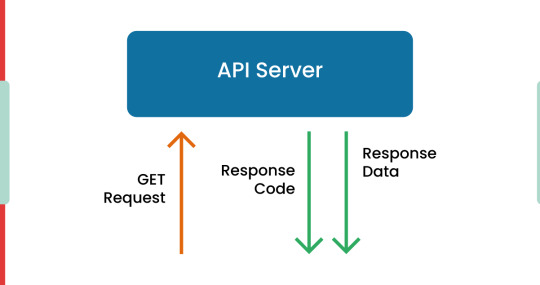
Use your preferred programming language or API client to send the HTTP request to the Zomato API endpoint.
Handle the API Response
Receive the JSON response from the API.
Parse the JSON data to extract the restaurant information you require. The data structure may vary based on the specific API endpoint.
Display or Use the Data
Utilize the obtained data according to your application's needs. You can display restaurant details, ratings, reviews, menus, and more.
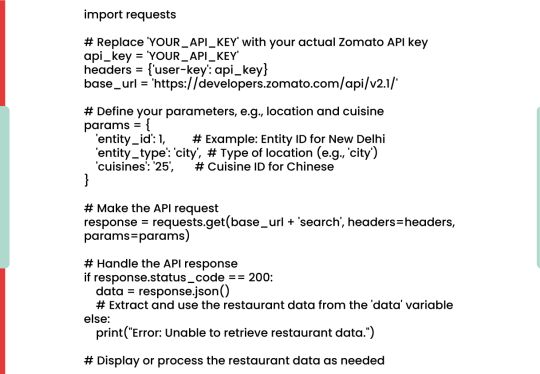
Please note that Zomato's API offers various endpoints for different purposes, so you can tailor your requests to obtain specific types of restaurant data. Make sure to read Zomato's API documentation for comprehensive details on available endpoints, parameters, and data formats.
The Different Types of Zomato APIs: A Comprehensive Overview
Zomato, a leading name in the world of restaurant discovery and food-related services, offers a range of APIs (Application Programming Interfaces) that cater to the diverse needs of developers, businesses, and food enthusiasts. These APIs provide access to a wealth of restaurant-related data, allowing developers to create innovative applications and solutions. In this detailed exploration, we'll delve into the various types of Zomato APIs and their specific use cases.
1. Zomato Search API
The Zomato Search API is a fundamental tool for discovering restaurants based on specific parameters. Developers can search for restaurants using various filters such as location, cuisine, establishment type, and user reviews. It's the go-to choice for applications that need to provide users with a curated list of dining options.
2. Zomato Restaurant API
The Restaurant API, as the name suggests, provides detailed information about a specific restaurant. Developers can access comprehensive data, including the restaurant's name, location, operational hours, user reviews, photos, and more. This API is ideal for applications that require in-depth knowledge about individual dining establishments.
3. Zomato Cuisine API
The Cuisine API focuses on one of the key aspects of dining - the type of cuisine. It allows developers to explore a wide range of cuisines and their availability in a given location. This API is beneficial for applications that want to offer users the opportunity to explore specific culinary experiences.
4. Zomato Category API
Categories play a crucial role in restaurant classification. The Category API provides information about different types of restaurants, helping users find the dining experience they desire. This API is essential for applications that aim to categorize and filter restaurants effectively.
5. Zomato Collection API
Collections often reflect popular themes or dining trends in a particular location. The Collection API enables developers to access curated lists of restaurants that fall under specific themes or categories. Applications that aim to showcase trending or unique dining experiences can benefit from this API.
6. Zomato Reviews API
User reviews are a significant part of the dining decision-making process. The Reviews API offers access to user-generated reviews, ratings, and comments about restaurants. This API is essential for applications that want to include authentic user feedback.
7. Zomato Location API
The Location API assists in retrieving information about different locations. Developers can access details such as the names of cities, localities, and establishment types. This API is beneficial for applications that require location-based services and recommendations.
8. Zomato Geocode API
Geocoding is crucial for accurately locating restaurants. The Geocode API converts an address into geographical coordinates (latitude and longitude), helping applications pinpoint the exact restaurant locations. This API is indispensable for mapping and navigation applications.
9. Zomato Delivery API
With the rise of food delivery services, the Delivery API has become vital. It offers information about food delivery options, minimum order amounts, and delivery times. Applications that focus on food delivery can use this API to provide valuable delivery-related details.
10. Zomato Dailies API
Dailies, or daily deals, are a popular aspect of dining out. The Dailies API provides information about daily specials, offers, and promotions at restaurants. Applications looking to showcase daily deals and discounts can integrate this API to provide real-time information to users.
11. Zomato User API
User profiles play a significant role in platforms that encourage user interactions. The User API enables developers to access user-specific data, including user profiles and activity. This API is essential for applications that aim to create a sense of community and engagement.
12. Zomato Collections API
Collections, as curated lists of restaurants, are a popular feature on the Zomato platform. The Collections API allows developers to retrieve information about these lists, making it possible for applications to feature curated dining options.
13. Zomato Table Booking API
Table reservations are a significant part of the restaurant experience. The Table Booking API allows developers to offer table reservation services to users, enhancing their dining experience through seamless reservations
14. Zomato Restaurant Widget API
The Restaurant Widget API provides developers with a widget that can be embedded into their websites. It allows for the integration of restaurant listings, reviews, and ratings, offering valuable content to users.
15. Zomato Gold API
Zomato Gold is a premium membership program offering discounts and benefits at partner restaurants. The Zomato Gold API provides access to information about Gold partner restaurants and their offers. It's essential for applications looking to incorporate Zomato Gold benefits into their services.
16. Zomato Pro API
Zomato Pro is another membership program that offers complimentary food delivery and dining experiences. The Zomato Pro API provides data related to partner restaurants and Pro-exclusive offers. Applications can use this API to enhance user experiences with Pro benefits.
17. Zomato Geospatial Search API
The Geospatial Search API combines location and cuisine searches, enabling developers to find restaurants within a specific area that offer particular cuisines. It's useful for applications focused on localized dining recommendations.
18. Zomato Lite API
Zomato Lite is designed for applications with limited resources or bandwidth. This lightweight version of the API offers essential functionality for restaurant discovery and access to basic data fields.
19. Zomato Developers API
The Developers API is the entry point for developers looking to explore and experiment with Zomato's API offerings. It provides access to basic data and functionality for development and testing.
Each of these Zomato APIs offers unique capabilities and data access, allowing developers to create a wide range of applications and services tailored to the needs of users, restaurateurs, and food enthusiasts. The choice of API depends on the specific requirements of your project, whether it's restaurant discovery, menu exploration, user engagement, or more. By leveraging the diverse capabilities of Zomato's APIs, developers can craft innovative solutions that enhance the dining experience and empower businesses in the culinary industry.
Conclusion
In this detailed guide, we've navigated the intricate world of the Zomato API and how to effectively harness it for scraping restaurant data. From searching for your favorite dining spots to obtaining in-depth restaurant details, Zomato's APIs empower developers and businesses to elevate the dining experience for users.
By understanding the various types of Zomato APIs, you can craft applications and services that cater to the diverse needs of food enthusiasts, restaurateurs, and culinary explorers. Whether you're building a restaurant discovery app, a food delivery platform, or a user engagement tool, Zomato's APIs provide the essential ingredients to create exceptional dining experiences.
Ready to embark on your culinary data journey? Start exploring the world of restaurants, menus, reviews, and more with the Zomato API, and unlock the potential for innovative and data-driven dining solutions. Begin your Zomato API journey today and savor the possibilities!
Know More: https://www.realdataapi.com/scrape-restaurant-data-using-zomato-api.php
#Zomato API to Scrape#Zomato Restaurant API#Scraping restaurant data#Zomato Collections API#Extract Zomato Data API
0 notes
Text
Food Delivery App Scraping Services | Extract Restaurant Menu Data
Elevate your food business with our Food Delivery App Scraping Services. We can extract restaurant menu data from the USA, UK, UAE, Canada, China, India, and Spain.
know more: https://www.mobileappscraping.com/food-delivery-app-scraping-services.php
#Food Delivery App Scraping Services#extracting data from food delivery app#Food Delivery Mobile App Data Scraping#Extract Restaurant Menu Data
0 notes
Text
A Guide to Scraping Restaurant Data from Deliveroo, Talabat, and Careem
Unlock the power of data with our comprehensive guide on scraping restaurant data from three of the most prominent food delivery platforms: Deliveroo, Talabat, and Careem.
know more https://medium.com/@actowiz/a-guide-to-scraping-restaurant-data-from-deliveroo-talabat-and-careem-982cec8a2c39
0 notes
Text
How To Scrape Zomato & Swiggy Data Using Python And BeautifulSoup?
Please read this blog to understand How to Scrape Zomato & Swiggy Data Using Python and BeautifulSoup? Food Data Scrape and use it for different business needs.
Know more : https://medium.com/@fooddatascrape/how-to-scrape-zomato-swiggy-data-using-python-and-beautifulsoup-aeb634bd77de
#Scrape Zomato & Swiggy Data Using Python And BeautifulSoup#Scrape Swiggy and Zomato Data#scrape Zomato restaurant data#scrape Swiggy restaurant data#Scrape data from Zomato and Swiggy#Extracting Swiggy and Zomato Data.
0 notes
Text

A complete guide on extracting restaurant data from Google Maps includes using web scraping tools like BeautifulSoup or Scrapy in Python, leveraging the Google Places API for structured data access, and ensuring compliance with Google's terms of service. It covers steps from setup to data extraction and storage.
0 notes
Text

Menu data extraction can be your secret weapon! By leveraging you can automatically extract & analyze menus from across the UK's Restaurant.
This gives you valuable insights into:
Pricing trends: Identify competitor pricing strategies for similar dishes.
Menu popularity: See what dishes are most popular & adjust your offerings accordingly.
Ingredient usage: Track which ingredients are trending & optimize your menu for cost efficiency.
With this intel, you can make data-driven decisions to stay ahead of the curve!
Read Full Article - UK Based Restaurant Menu Data Extraction
#data extraction#web scraping#big data#lensnure solutions#web scraping services#Restaurant Data Scraping#Food Data Scraping#USA
1 note
·
View note
Text
Food Delivery and Menu Data Scraping Services
Need menu data scraping for food delivery services? Our Restaurant Menu Scraper extracts restaurant details, pricing, and menus from USA, UK, Australia, Germany, Canada, and UAE apps.

#Food Delivery And Menu Data Scraping Services#food delivery data scraper#Scrape From Food Delivery Websites#extract food delivery data#Restaurant Menu Scraper#Scrape Food Delivery Data
0 notes
Text
How to Maximize the Benefits of Restaurant Menu Scraping
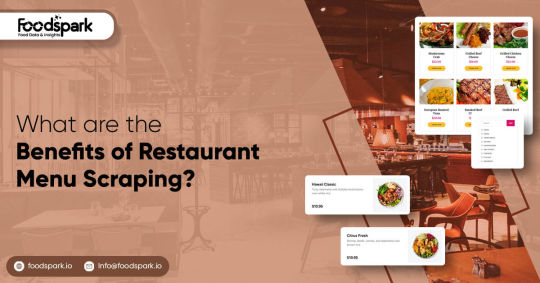
Introduction:
In the ever-evolving landscape of the restaurant industry, staying competitive requires innovative strategies and a deep understanding of market trends. One such tool that has gained prominence is restaurant menu scraping – the process of extracting data from online menus. By leveraging this technique effectively, businesses can unlock a wealth of insights, streamline operations, and enhance the overall dining experience.
I. Understanding Restaurant Menu Scraping:
Restaurant menu scraping involves the automated extraction of data from digital menus available on restaurant websites or third-party platforms. This data can include menu items, prices, descriptions, and more. The primary goal is to convert unstructured information into a structured format that can be analyzed and utilized for various purposes.
II. Enhancing Competitive Intelligence:
One of the primary benefits of restaurant menu scraping is the ability to gather valuable competitive intelligence. By monitoring competitors' menus, pricing strategies, and promotional offers, restaurant owners can make informed decisions to stay ahead in the market. This insight allows for strategic adjustments to menu offerings, pricing, and marketing campaigns to align with customer preferences and market trends.
III. Optimizing Menu Design and Pricing:
Menu scraping provides detailed information on the popularity of specific dishes, customer preferences, and pricing strategies within the industry. Analyzing this data enables restaurant owners to optimize their own menus, highlighting popular items, adjusting prices to remain competitive, and identifying opportunities to introduce new dishes that resonate with customers.
IV. Streamlining Inventory Management:
Efficient inventory management is crucial for minimizing waste and maximizing profits. Restaurant menu scraping aids in tracking ingredient usage, identifying fast-moving items, and anticipating demand fluctuations. This data-driven approach enables businesses to optimize their supply chain, reduce inventory costs, and maintain a more accurate inventory turnover.
V. Personalizing Customer Experiences:
Understanding customer preferences is key to delivering personalized dining experiences. With menu scraping, restaurants can analyze customer choices, dietary preferences, and order histories. This information can be leveraged to create targeted marketing campaigns, loyalty programs, and customized promotions that resonate with individual customers, fostering customer loyalty and repeat business.
VI. Monitoring Market Trends:
The restaurant industry is dynamic, with trends evolving rapidly. Menu scraping allows businesses to monitor market trends in real-time. By staying abreast of changing consumer preferences, emerging food trends, and popular cuisines, restaurants can adapt their menus and marketing strategies to capitalize on the latest trends, ensuring they remain relevant and appealing to their target audience.
VII. Improving Operational Efficiency:
Beyond menu optimization, restaurant menu scraping contributes to overall operational efficiency. By automating the extraction of menu data, staff can focus on more value-added tasks, such as customer service and food preparation. This not only saves time but also reduces the risk of errors associated with manual data entry.
VIII. Legal and Ethical Considerations:
While the benefits of restaurant menu scraping are clear, it's crucial to address legal and ethical considerations. Ensure compliance with copyright laws, terms of service for websites, and data protection regulations. Obtaining explicit permission or using publicly available data is essential to avoid legal complications.
Conclusion:
In the digital age, harnessing the power of data is paramount for success in the restaurant industry. Restaurant menu scraping is a valuable tool that can revolutionize how businesses operate, from enhancing competitive intelligence to optimizing menus and improving customer experiences. By adopting ethical practices and leveraging data responsibly, restaurant owners can unlock the full potential of menu scraping and pave the way for sustained growth in an ever-evolving market.
#web scraping services#food data scraping services#food data scraping#restaurant data scraping#Restaurant Menu Scraping#grocerydatascraping#restaurantdataextraction#grocerydatascrapingapi#fooddatascrapingservices#Restaurant Menu#food menus#restaurant menu extraction
0 notes
Text
Tripadvisor Scraping | Extract Hotels and Restaurants Data

Introduction
Leveraging the appropriate API makes scraping TripAdvisor on a large scale a straightforward task. You don't need to possess advanced computer skills to achieve this. Our comprehensive, step-by-step guide is designed to walk you through extracting data from TripAdvisor using a user-friendly web scraping tool.
TripAdvisor stands out as a powerhouse with an extensive database comprising over 8 million locations, 1 billion reviews, and support for 29 languages. As of 2022, when the cumulative reviews surpassed the one billion mark, it became evident that TripAdvisor's meticulous gaze would soon cover every restaurant, hotel, vacation rental, or attraction listing.
Unlocking the Potential: The Advantages of Scraping TripAdvisor Data

Demystifying the TripAdvisor Content API: Your Gateway to Seamless Data Integration
The TripAdvisor Content API, formerly the TripAdvisor API, offers an official avenue for scraping TripAdvisor data. A significant evolution from previous years, the TripAdvisor Content API streamlines the process, requiring less rigorous vetting for access. Interested enthusiasts can explore various TripAdvisor APIs on the official platform. Unlike in the past, obtaining a key has become less restrictive, opening doors for developers to effortlessly tap into TripAdvisor’s wealth of data and seamlessly integrate it into their websites and applications.
This API provides access to diverse information, including details on accommodations, restaurants, and attractions. Users can extract valuable data such as review links, ratings, awards, accommodation categories, attraction types, and restaurant cuisines. The TripAdvisor Content API simplifies the extraction process. It empowers developers to enhance their platforms with real-time, relevant data from one of the most comprehensive global travel and hospitality databases. Dive into the world of data-driven development with the TripAdvisor Content API.
Navigating the Constraints of the TripAdvisor API: Considerations and Alternatives
While the TripAdvisor API presents a convenient means to access data, notable limitations warrant careful consideration. One key constraint involves the restricted scope of data accessible through the API. If you've been following closely, the bullet list earlier merely scratches the surface of TripAdvisor’s comprehensive dataset. Crucial elements like vacation rentals, detailed restaurant reviews, activities, pricing information, itineraries, and addresses may not be readily available via the API, necessitating alternative approaches for comprehensive data extraction.
Moreover, the TripAdvisor API imposes specific restrictions on data volumes, introducing further complexities. These include limits such as extracting only up to 5 reviews and 5 photos per location, a monthly cap of 5,000 free API calls, a maximum of 10,000 calls per day even with payment, the allocation of only one API key per account, mandatory setting of a daily budget, and immediate provision of billing information. Additionally, meticulous monitoring of API usage is essential to prevent accidental overages.

Finally, while the API offers TripAdvisor data in an organized format, seamlessly incorporating this data into your website or application may pose challenges. It necessitates programming proficiency to manage API requests, parse the data, and present it in a user-friendly manner. This task can be more intricate than web scraping, where you have direct influence over data extraction and presentation. Now, let's explore how a straightforward scraper can be employed.
Why Should You Use TripAdvisor Scraper?
The Tripadvisor Scraper offers a streamlined solution for large-scale data extraction, allowing users to download information in various structured formats like JSON, CSV, XML, or Excel files. Remarkably, no programming or coding skills are required to operate this tool. As an unofficial Tripadvisor API, it automates the extraction process, simplifying and expediting the scraping of Tripadvisor data. This efficiency allows users to focus on leveraging the extracted data to enhance and benefit their business without needing extensive technical expertise.
List of Data Fields

Business Name
Address
Phone Number
Website
Email (if available)
Category/Type of Business
Overall Rating
Number of Reviews
Individual Review Ratings
Reviewer's Username
Review Date
Latitude
Longitude
City
Country
Region
Price Range
Operating Hours
Amenities
Photos
Popular Dishes/Services
Wheelchair Accessibility
Parking Availability
Wi-Fi Availability
Reservation Options
Booking Website Links
Discounts
Promotions
Links to Social Media Profiles
Changes in Ratings Over Time
Trends in Reviews
Legal Compliance in Extracting TripAdvisor Data: Navigating the Terrain
Extracting data from TripAdvisor is legally permissible due to its public nature. Scraping details from hotel pages aligns with accepted practices, but strict compliance with regulations like GDPR or CCPA is crucial, mainly when dealing with personal data like reviewer names. Caution must be exercised to avoid scraping copyrighted or private content, ensuring a responsible and lawful data extraction process.
How to Extract data from TripAdvisor?
To initiate the process of data scraping from TripAdvisor, follow our simple 5-step guide using the TripAdvisor Scraper:
Step 1: Navigate to the TripAdvisor Scraper Page
Click on the TripAdvisor Scraper page.

Step 2: Select the Target Location for Scraping

Please provide start URLs to crawl.
You can change this later by going to your crawler>Settings>Start URLs Whether it's hotels, vacation rentals, restaurants, or attractions, you have the flexibility to gather information from any globa destination available on TripAdvisor

Press ‘Continue’.
Step 3: Initiate Scraping by Clicking Start

Simply click on the "Start" button and patiently await the results. The scraping process may take a few minutes.
Step 4: Retrieve Your Extracted Data

Once your task is done, you will get the ‘Finished’ status and then you will be able to ‘View’ and ‘Download’ data in Excel (CSV), JSON, and XML format.
How to Extract TripAdvisor Reviews?
If your goal is to specifically scrape reviews, consider using the TripAdvisor Reviews Scraper. This specialized tool allows you to gather valuable data for your analytics, including review title, text and URL, rating, published date, basic reviewer information, owner's response, place details, and more. Whether it's for restaurants, tourist attractions, hotels, or any other entity with reviews on TripAdvisor, this scraper is designed to capture relevant information.
You need to follow the same procedure discussed above for scraping TripAdvisor review data.
Contact Actowiz Solutions for more details. You can also reach us for all your mobile app scraping, instant data scraper and web scraping service requirements.
#Tripadvisor Scraping#Extract Hotels Data#Extract Restaurants Data#Extract TripAdvisor Data#Scrape TripAdvisor Data API
0 notes